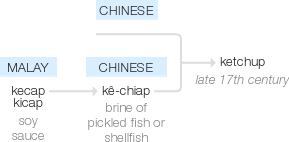Ketchup
late 17th century: apparently from Chinese (Hokkien dialect) kê-chiap ‘brine of pickled fish or shellfish’, perhaps partly via Malay kecap, kicap ‘soy sauce’.
wiktionary
Uncertain, but probably ultimately from Chinese via Malay kicap, from Min Nan 膎汁 (kê-chiap, “fish broth”), though precise path is unclear – there are related words in various Chinese dialects, and it may have entered English directly from Chinese. Cognate to Indonesian kecap, ketjap(“soy sauce”). Various other theories exist – see Ketchup: Etymology for extended discussion.
First appeared in English in the late 17th century in reference to a Southeast Asian sauce encountered by British traders and sailors. The Oxford English Dictionary notes that it was commonly used in the 18th century to refer to a variety of similar sauces with varying ingredients—"anchovies, mushrooms, walnuts, and oysters being particularly popular"—but by the late 19th century the current tomato ketchup became the most popular form. [1]
Catsup (earlier catchup) is an alternative Anglicization, still in use in the U.S.
etymonline
ketchup (n.)
1711, said to be from Malay (Austronesian) kichap, but probably not original to Malay. It might have come from Chinese koechiap "brine of fish," which, if authentic, perhaps is from the Chinese community in northern Vietnam [Terrien de Lacouperie, in "Babylonian and Oriental Record," 1889, 1890]. Catsup (earlier catchup, 1680s) is a failed attempt at Englishing, still in use in U.S., influenced by cat and sup.
Originally a fish sauce made from various plant juices, the word came to be used in English for a wide variety of spiced gravies and sauces; "Apicius Redivivus; or, the Cook's Oracle," by William Kitchiner, London, 1817, devotes 7 pages to recipes for different types of catsup (his book has 1 spelling of ketchup, 72 of catsup), including walnut, mushroom, oyster, cockle and mussel, tomata, white (vinegar and anchovies figure in it), cucumber, and pudding catsup. Chambers's Encyclopaedia (1870) lists mushroom, walnut, and tomato ketchup as "the three most esteemed kinds." Tomato ketchup emerged c. 1800 in U.S. and predominated from early 20c.
